Is Worm Tea Really That Good?
What It Is
Worm tea is the liquid concentrate of worm compost. Minerals and microbial elements are extracted from the solid compost by actively brewing in water by means of an air pump which forces oxygen into the liquid.
"A primary reason for producing a compost tea is to transfer microbial biomass, fine particulate organic matter, and soluble chemical components of compost into a solution that can be applied to plant surfaces and soils in ways not possible or economically feasible with solid compost."[USDA Compost Tea Task Force Report, April 2004]
While a compost extraction can be made by simply stirring, it's made even better if continuous oxygen is incorporated into this "compost broth" which can increase the original numbers of microbes into the billions. This is known as AACT or actively aerated compost tea.In this case, worm tea.
What It's Not
The watery drainage that seeps out of the bottom of a bin is not compost tea as many sites assert. Leaching through yet undigested food waste, this leachate (as it is known) could contain toxic anaerobic microbes that would be harmful to plants.
Not only will there be unmineralized organic compounds, but there is the potential for contamination of pathogen organisms and coliform bacteria that can come from some of the raw materials (another reason to always pre-compost fresh manure) put into worm bin systems.
The best place for this leachate to go is back in the bin. That way, it gets exposed to the worm's gut to be innoculated with good microbes and is excreted fully sanitized.
Technically speaking, soaking or steeping compost in a bucket of water is not compost tea. This is termed a liquid compost extract. It is beneficial to a certain extent, but you don't get the growth of microbes as in the aerated version.
How To Make a Worm Compost Extraction
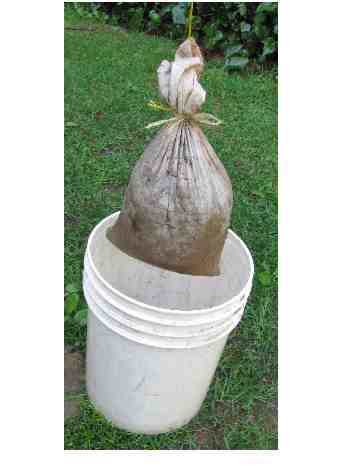
Non-continuous aeration method:
Fill a used burlap or paint strainer bag with worm compost at the rate of 1:5 (lbs of compost:gallons of water)and set it in a 5 or 6 gallon bucket of warm water. Pond or rain water is best, but if using tap water, let it sit an hour (preferably in the sun) to dissipate the chlorine as it is anti-bacterial and anti-fungal. Process tea for 24-48 hours, stirring every couple of hours during the day. According to "Organic Farming Research Foundation", Winter 2001 No.9
"Our results confirm those of others: so-called anaerobic tea systems—those in which organic stock is simply soaked in water—are actually aerobic for the first 48 hours or so of extraction. After that, they become anaerobic. In other words, aerated or aerobic systems simply extend the time of useful extraction by replacing or adding oxygen into a system that would otherwise go anaerobic. It should be the goal of all organic tea extraction methods to avoid anaerobic conditions."
Active Aeration method: Simple shop vac pump (in blue)attached to a length of 1" PVC pipe Perforated PVC cap that fits at the end of the vacuum tube
Using an aerator will give much better worm tea results as it produces a much higher microorganism count due to increased O2.
The aerator should run for 12-24 hours. An aquarium bubbler may only provide sufficient oxygen in a 4-5 gallon bucket, but in larger containers the water would be too deep for the bubbler to work adequately. I have found, as seen in the pictures, that a vacuum pump works very well, but not for very long! (We've gone through 3 so far and it's time for something more substantial-see below) It not only injects sufficient air into the water, but breaks the surface tension allowing for more dissolved oxygen in the water. The point is not merely to saturate the tea with O2, but the surface tension must be broken to release CO2 as well.(this last point was gleaned from
Microbe Organics To provide a food source for the bacteria and fungi, add 1 oz of fish hydrosolate (not emulsion), liquid kelp and 2 tablespoons of unsulphured, blackstrap molasses for every 5 gallons of water.
Foam on the tea surface is a good indication of free proteins, amino acids or carbohydrates and the sign of a good aerobically brewed tea.
When the brewing time is finished, let it sit for about 30 minutes so any solid matter can settle to the bottom. Filter the solution through a piece of fine netting, window screen or paint filter if you plan to use a sprayer(it has been noted that pantyhose may be too restrictive in not letting some microbes through). This will filter out small particles that could clog a spray nozzle or just remove the spray end and you won't need to filter. A sprinkling can works fine when you don't have to filter the tea.
For best results, the worm tea should be used as quickly as possible.. Once the oxygen and food are consumed, anaerobic organisms will begin to take over, producing alcohols and phenols toxic to plants.
Keep in mind that microbial growth in the worm tea will be slower to form in the winter than summer. Making this in a shed or garage in the early spring would be advisable where warm water of 70° can be used. In the summer, do not expose to sunlight as UV rays can kill microbes also. Best to use it either in early morning or late in the afternoon. 
providing aeration for tea brewing
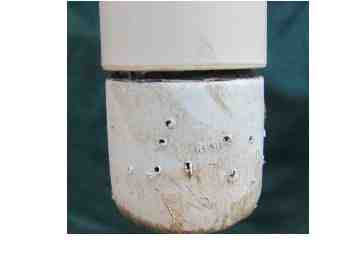
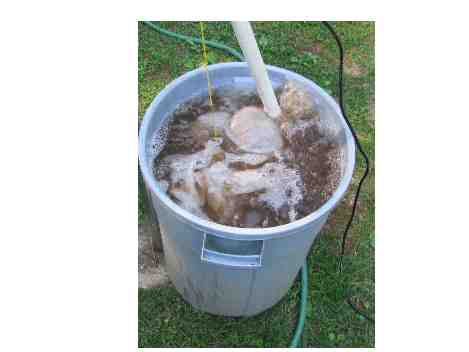
******UPDATE******
We have upgraded our tea brewing using a 42 gallon drum, a larger outdoor air pump, and a brewer that bubbles from the bottom of the drum.
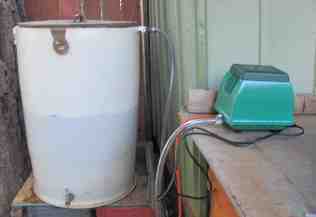
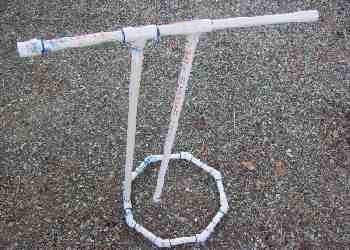
Qualities of Worm Tea
The quality of the worm tea is largely dependent on the quality and variety of feedstock used in the compost.
Some of the microbes contained in various worm composts have also been shown to have disease suppressant qualities and can give some degree of protection to crops from various root and foliar pathogens.
The important thing to remember when you are making a worm tea is to only make it from fully processed mature compost. The worms have completely worked the organic matter so that no raw material particles are left.
Application Rates and Methods
If there are signs of disease or pests, use undiluted until the plant is back in health.
For larger acreage, use 5 gallons/acre.
* Always use de-chlorinated water, rainwater, pond or distilled water when making worm compost tea.
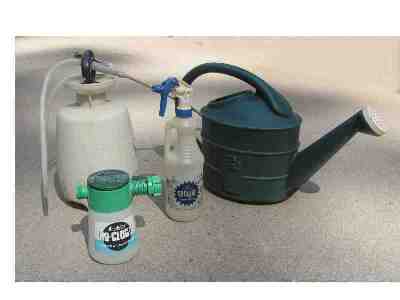
Worm tea applications can be made by using inexpensive equipment you probably already own; such as (left to right)
Back to Top...
From Worm Tea to Compost Tea Research
Return to Sierra-Worm-Compost Homepage
Serving No. Calif counties of El Dorado, Nevada, Placer and Sacramento.
Copyright 2010-2012 Sierra Worm Compost.com
All Rights Reserved



New! Comments
Leave a comment in the box below.